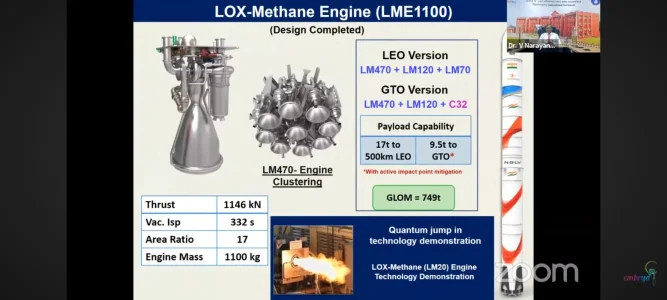- Joined
- Jun 27, 2024
- Messages
- 4,303
- Likes
- 25,219
We expected SOORYA ICBM, but we got SOORYA space launch vehicle
View: https://x.com/Rethik_D/status/1815299491446018484
Kerala | PSLV not immortal. Don't have a clear time in mind but it will not stay for another 100 years. PSLV was developed in the 1980s, hence does not serve the needs of 2020s. Evolution has to happen: ISRO Chairman, S Somnath


Vamsi said:Launch Vehicle Performance Calculator
using the above website I made some estimations for the empty weights of stages for proposed NGLV powered by SCE-200 & CE-20 engines, I excluded Methalox engines for now as we don't know the targeted specific impulse of those engines
For NGLV to carry 10tons to GTO (36000 x 185 Km, 22 deg inclination) & 22.5 tons to LEO ( 185 x 185 km, 45deg inclination) in fully expendable mode, it should have the following specs
1st stage - SC450
engines: 5 x SCE-200
Total thrust: 9100KN
Isp: 299 sec
empty weight( should not exceed): 35000Kg
2nd stage- SC120
engines: 1 x SCE-200
Thrust: 2030KN
Isp: 335sec
empty weight( should not exceed): 8500Kg
3rd stage - C32
engines : 1 x CE-20
Thrust: 220KN
Isp: 443sec
empty weight(should not exceed): 4500Kg
Above empty weights should be the target, if ISRO wants to achieve 10Tons to GTO using SCE-200 & CE-20 engines
C-25 stage currently used in LVM-3 has dry weight of 4300 Kg with 28tons of propellent loading, they have to maintain almost the same empty weight ,but increase the propellent loading to 32 tons, this can achieved if they can use the common bulk head & balloon tanks like in Centaur Upper Stage of Atlas-V
SC120 currently being developed for LVM-3SC has dry weight of 11500 Kg, they should reduce it by 3000Kg by using Aluminium-Lithium alloys, balloon tanks just like in Falcon 9 & use common bulk head, they should use same methods for SC450 stage too to reach the above required empty weight.
development of NGLV will be challenging for ISRO, they should develop extremely light weight tanks, if they want to reach 10tons to GTO in expendable mode
NGLV can achieve 6tons to GTO & 16tons to LEO in booster reusable mode

The architecture for Indian Space Research Organisation’s (ISRO), ambitious Next Generation Launch Vehicle (NGLV) has been finalised, ISRO chairman S. Somnath has said.
Speaking to presspersons at the SMOPS-2023 International Conference on Spacecraft Mission Operations here on Thursday, he said that the team working on the NGLV programme had already submitted a preliminary report focusing on what the rocket should look like.
He added that ISRO wanted the NGLV to be partially reusable and that the boosters should be reusable.
Source for the last Image which has S160 boostersLME-1100 Nozzle Design and Naming of Project Soorya
View attachment 3931View attachment 3932View attachment 3933View attachment 3934View attachment 3935View attachment 3936View attachment 3937View attachment 3939
Man, with the way NGLV is going to use new materials and techniques, no wonder timing is around 2034.
But, this is 10 long years.
I hope sce-200 come fast online.
Some PPT. Will try to find it again.Source for the last Image which has S160 boosters
Thats a stupid news to announce(even rumour mongering for follower farming prespective). This should be secret and anounced only after test just like ASAT.
And if there is even .0001% possibility that India this time is really planning (after countless rumours since last 3 decades) .. it shall be put into cold bag if Trump comes into power.
It maybe for leverage ?? for all we know it maybe completed?
having Surya means just adding another stage to Agni 5. If they are really keen to have ICBM quickly.
We are developing ICBM class of vehicles but they are not for launching weapons but just in time sattelites. VEDA comes to mind.
if we can send a rocket to the moon then surya should be easy?
Engineering does not work that way, may be when you have resources like China or USSR and able to fund and also have human resources that are capable and have a vast supply chain to do so....ISRO is budget conscious and thats why it should be based on where we are as a country. One of the few public sector orgs that punch above their weight already.
All the early Icbm's were developed in space programs especially by USA and Russia.
I don't know about the technicals but t should not be any different for India?
I don't think Lethal was talking about Surya missile, he was talking about the seemingly longer timelines of this Surya rocket when we already have tech and my posts was around that too that icbm tech does not directly translate to churning new rockets like peanuts. There are lot of other things especially different economics behind designs.Regards
- Agni-6' future depends upon political factors. There is no technological challenge involved here (nor there is any requirement until west turns militarily hostile).
- Surya missile is a cancelled 90s concept and is unrelated to Agni-VI regardless of media botching it.
- This thread is on Project Surya (Rocket) and not Surya missile. Move the posts to needful place please.
No, there are not any significant/impactful differences where a country with orbital launch technology would be troubled making a global range ICBM. Turnaround time and size are the factors which apart Rockets from BMs and you automatically do most of your work here when you remove upper stages of the rocket, turning it into a ballistic missile ag first place.I don't think Lethal was talking about Surya missile, he was talking about the seemingly longer timelines of this Surya rocket when we already have tech and my posts was around that too that icbm tech does not directly translate to churning new rockets like peanuts. There are lot of other things especially different economics behind designs.
Sure, whatever you say. May I ask which industry you work? I have been life long in manufacturing and your argument is nonsensical at best....take any field. Unless you are USSR/China or USA which prints money being reserve, most things in engineering require their own deep diving and have their own boundaries to deal with. ICBM and rockets operate in totally different boundaries in which their design basis and tolerances are studied. Just because you know how to build a suv engine does not mean you can build a ferrari level engine without going through a process....I gave you an example of Angara, which is taking its own timeline and exactly for those reasons. They know how to build rockets and icbms and various other things....over simplification is what is done here, if you are doing any serirous job in any field then you get the scale of building something that is reliable whether its software or assembly lines or food processing.No, there are not any significant/impactful differences where a country with orbital launch technology would be troubled making a global range ICBM. Turnaround time and size are the factors which apart Rockets from BMs and you automatically do most of your work here when you remove upper stages of the rocket, turning it into a ballistic missile ag first place.
Rockets can simply translate into long range ballistic missiles and not vice versa. Agni 6 is strictly a political cause.



